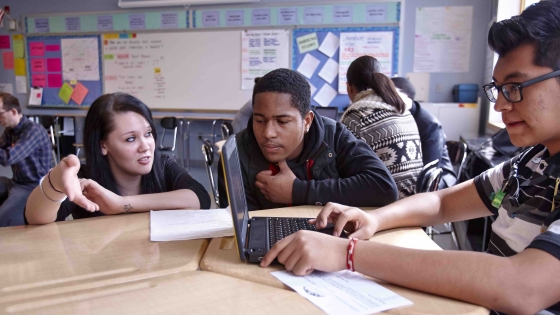Successes, Challenges, and Implications of NYC's CS4All Initiative
By Cheri Fancsali and June Mark, with Kathryn Hill, Xia Li, Janice Lee, Rishika Jain, and Michelle Flores
(December 2024)
Launched in 2015, New York City's Computer Science for All (CS4All) initiative sought to provide all students across the system with at least one CS experience at each grade band (K–2, 3–5, 6-8, and 9–12). The initiative placed particular emphasis on broadening participation among girls, and Black and Latinx students, who are underrepresented in CS careers and classrooms nationwide. This report synthesizes findings from a multifaceted and wide-ranging evaluation of the initiative conducted by the Research Alliance for New York City Schools and Education Development Center between 2016 and 2024.
Guided by the CAPE framework (Capacity, Access, Participation, Experiences; Fletcher & Warner, 2020), the report highlights CS4All’s successes and challenges and outlines implications for future CS education efforts. Our findings show that the initiative made significant strides in expanding computer science education in New York City, including:
- Building capacity by training over 3,000 teachers and engaging over 600 school leaders in CS-related professional learning opportunities.
- Expanding student access and participation in CS: The percentage of schools offering some form of CS tripled, from 15% during the first year of the initiative to 45% in 2022-23. During this time, the number of students taking a CS unit or course grew from 54,000 per year to nearly 170,000.
- Narrowing gender and race/ethnicity disparities in CS participation— although substantial gaps remain, with girls and Black and Latinx students still underrepresented in CS classes, particularly at the middle and high school levels.
- Demonstrating growth in student outcomes. Taking CS was associated with improved computational thinking skills and CS-related attitudes, especially among elementary students. CS course-taking in high school was associated with an increased likelihood of going on to declare a CS major in college and, importantly, with smaller gender and race/ethnicity gaps in the pursuit of CS degrees.
- Embedding culturally responsive practices in CS instruction, which emerged as a promising strategy for enhancing student engagement in CS coursework across grade levels.
Despite these successes, by 2022-23, only 38 percent of NYC students had met the initiative’s original goal of taking at least one CS course or unit within their three- or four-year grade band. Our study identified a number of challenges that hindered the implementation of CS in many schools, such as scheduling difficulties, competing priorities, lack of preparation time, and changes in teaching assignments. These challenges were particularly acute in schools serving higher-needs students and greater proportions of Black and Latinx students, reflecting longstanding economic and racial inequalities.
Our study also documented factors that helped facilitate CS implementation. These included having a professional community of CS teachers to collaborate with, support from school and district leaders, a positive school culture around CS, alignment with other instructional priorities, partnerships with CS-focused nonprofits and businesses, and dedicated common planning time.
Overall, the CS4All initiative made significant progress in expanding access to CS education in NYC schools, but ongoing efforts are needed to address persistent equity gaps and ensure that all students have the opportunity to benefit from high-quality CS learning experiences. We hope the findings from our study provide useful insights for CS4All stakeholders here in NYC and for other similar initiatives around the country.

